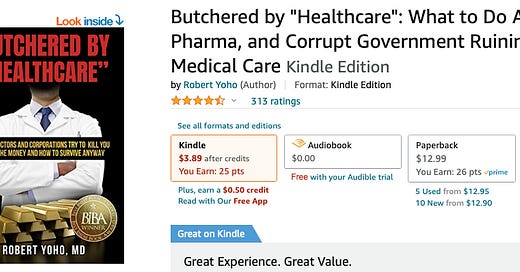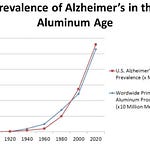About Cassandra’s Memo: You may download an ebook copy HERE and pay what you think it is worth. If you are short, it is my gift—no worries. The paperback is available at Barnes and Noble HERE. Please review it! As for Amazon, I replaced my transgender sections with links and changed my subtitle. Stay tuned to see if this gets me un-censored.
Note: I was alerted to the my topic by the thread HERE on Mathew Crawford’s Rounding the Earth Substack.
I have been criticized for being too hard on psychiatry. One reader compared me with the Scientologists and asked me if I would deny a (brain-damaging and addictive) antidepressant drug to a depressed pregnant woman. (YES.) I admit that my fervor seems almost religious, but this post will convince you that the shrinks deserve it.
“Psychopathy” has been removed from the psychiatrists’ diagnostic manual, the Diagnostic and Statistical Manual of Mental Disorders V. Narcissistic Personality Disorder was also deleted (from the newest edition, text revision DSM-5-TR). Are the psychopaths trying to conceal what they are from the rest of us?
Psychiatry has only the lamest of scientific grounding and, worse, is being weaponized to promote agendas. This LinkedIn post by a Ph.D. is an example:
The author describes racism as a mental disorder with constructs derived from DSM-5 criteria for Social Phobia, Paranoia, and Antisocial Personality Disorders. Selected criteria are merged and modified to form clinically applicable nomenclature under the proposed heading of Racial Psychopathological Disorder. Additionally, the author explains how this pathology manifests in the Make America Great Again (MAGA) sociopolitical movement, specifically, how it renders its participants susceptible to psychological denial and Delusional Disorder. A case study history contrasting Nazi Germany with MAGA culture is presented to illustrate the potential outcome of a manifested state of group psychopathology in this regard and the urgent need for American federal government Justice Department policy reform.
This loose chain of illogic goes: “racism”=Nazi=MAGA=diagnosable mental disorder=law enforcement and/or brain-damaging psych drugs required. Peter Breggin is concerned that trends like this will result in the forced medication of political opponents. When you understand this, his objections to Malone’s “mass formation psychosis” idea become clear.
To explain just how pathological psychiatry is, you need more background. I explain in a chapter from Butchered by “Healthcare,” Psychiatry is in Deep Crisis.
If you cannot afford to buy the book, HERE is a free link to download the ebook. Come back and flip me a few bucks if it changes your life. Please review it HERE. The Amazon paperback is currently on sale for $12.99, which may be below printing costs. This SECRET LINK is the audio for the first half of the book. It is free for you and your friends alone.
Psychiatry is the drug industry's paradise, as definitions of psychiatric disorders are vague and easy to manipulate. Leading psychiatrists are... at high risk of corruption and, indeed, psychiatrists collect more money from drug makers than doctors in any other specialty. Those who take the most money tend to prescribe antipsychotics to children most often. Psychiatrists are also “educated” with industry's hospitality more often than any other specialty. This has dire consequences for the patients.
Peter Gøtzsche, Deadly Medicines and Organized Crime (2013)
How modern psychiatry developed: A few decades ago, psychiatrists were losing their status. Then, the fabrication of new diagnoses along with the invention of medications to treat them saved them economically. First the antidepressants, and then the newer antipsychotics came to the rescue. This moved the specialty into the medical mainstream because the psychiatrists were the only ones who purportedly understood it all.
The novel diagnoses—some say concoctions—were enshrined in the psychiatric manual, the Diagnostic and Statistical Manual of Mental Disorders (DSM). Pharmaceutical companies played a huge role in its creation.
The American Psychiatric Association (APA) started aggressive disease-mongering of the new ailments. They hired ad agencies to produce “public service” drug advertising. The corporations marketed the new supposed cures alongside.
By 2008, twenty-eight percent of the APA’s income came from drug companies. According to influence theory, this made the APA virtually a subsidiary of the companies. Senator Chuck Grassley (R, Iowa) publicized the story in a congressional investigation.
Ben Furman, MD, a psychiatrist in Finland, explained how it happened in a 2018 blog:
The psychoanalytic belief system was thrown out and replaced with the DSM and the biomedical doctrine: everyone should have a diagnosis, and everyone should have medication. The psychiatrists now treated all the conditions that had been treated with therapy with medication. This became the treatment of choice for almost all mental health conditions regardless of whether the patient was an adult, teenager or child. A patient without medication became a rarity. The data system of mental health services required clinicians to diagnose anyone who sought help.
The psychiatrists and corporations ignored studies showing damage from long-term drug use. They left disparaging critics out of the debate and out of the textbooks.
Finally, long after the science matured, a few of the doctors are telling the truth. In 2012, an editorial in the British Journal of Psychiatry said the psychiatric medication revolution was at an end. Others now echo this sentiment.
The DSM is a kind of chaotic bible used to promote mental diseases. With its code numbers used for insurance, some call it the billing bible. Created primarily by psychiatrists on industry payroll, it mutates and metastasizes every few years through a vote of the APA members. In 2017, after many editions, it was 947 pages long.
Insiders have decried its intellectual disarray for decades. It has become the perverse standard in the service of drug marketing. The following are a few inside opinions about it:
There was very little systematic research, and much of the research that existed was really a hodgepodge—scattered, inconsistent, and ambiguous. I think the majority of us recognized that the amount of good, solid science upon which we were making our decisions was pretty modest.
Christopher Lane in Shyness: How Normal Behavior Became a Sickness (2007), quoting one of the DSM's contributors.
I pictured all these normal-enough people being captured in DSM-5’s excessively wide diagnostic net, and I worried that many would be exposed to unnecessary medicine with possibly dangerous side effects. The drug companies would be licking their chops figuring out how best to exploit the inviting new targets for their well-practiced disease mongering. I was keenly alive to the risks because of painful firsthand experience—despite our efforts to tame excessive diagnostic exuberance, DSM-IV had since been misused to blow up the diagnostic bubble.
Allen Frances, lead psychiatrist, DSM IV, author, Saving Normal (2013)
The National Institute of Mental Health (NIMH) in 2013 finally tossed the DSM—psychiatry’s diagnostic system—into the wastebasket.
Bruce E. Levine, psychologist and journalist.
Of the 170 contributors to the most recent edition of the ... DSM... ninety-five had financial ties to drug companies, including all of the contributors to the sections on mood disorders and schizophrenia… Not only did the DSM become the bible of psychiatry, but like the real Bible, it depended a lot on something akin to revelation. There are no citations of scientific studies to support its decisions. That is an astonishing omission.
Marcia Angell (2011), former editor-in-chief of NEJM
The DSM’s diagnostic categories lack validity, and the NIMH will be re-orienting its research away from DSM categories.
Former NIMH Director Thomas Insel
The authors of the DSM seem more preoccupied with politically correct jargon than substance. There are hundreds of psychiatry blogs where participants argue obsessively about the terminology, and there is a massive effort in each edition to update it.
For example, they changed Mental Retardation to Intellectual Disability. In 2010, this change was written into federal law. Multiple Personality Disorder morphed into Dissociative Identity Disorder for the DSM-V. Other diagnoses were hatched, for example Disruptive Mood Dysregulation Disorder and Premenstrual Dysphoric Disorder. This was formerly Late Luteal Phase Dysphoric Disorder. For many more samples, scan the entire document online. I read it for hours and did not think it got any better.
To understand the DSM V better, see the following excerpt:
Criteria for Oppositional Defiant Disorder:
A pattern of angry/irritable mood, argumentative/defiant behavior, or vindictiveness lasting at least 6 months as evidenced by at least four symptoms from any of the following categories, and exhibited during interaction with at least one individual who is not a sibling.
Angry/Irritable Mood:
1. Often loses temper.
2. Is often touchy or easily annoyed.
3, Is often angry and resentful.
Argumentative/Defiant Behavior:
4. Often argues with authority figures or, for children and adolescents, with adults.
5. Often actively defies or refuses to comply with requests from authority figures or with rules.
6. Often deliberately annoys others.
7. Often blames others for his or her mistakes or misbehavior.
Parents of boys need no other commentary unless they support using medications with pernicious side effects to suppress normal, but somewhat irritating behavior.
The DSM has worldwide influence. It is the ultimate resource for courts, doctors, prisons, hospitals, and insurance companies. These diagnoses lock people into legal and therapeutic boxes, but they are of dubious benefit since the drugs work poorly and promote chronicity. Since withdrawal from these medicines is severe and mimics the conditions treated, long-term use becomes almost inevitable.
The corporations blatantly falsify research to get psychiatric drugs approved. The study deceits I reviewed in the FDA chapter are all used. Studies that show drugs do not work get concealed. Positive reviews get published multiple times, and the journals mostly only print the data that show the drugs work. These last two tricks are such standard practice that the drugmakers have internal nicknames for them: “salami-slicing” and “cherry-picking,” respectively.
Another often-used fraud is to compare massive doses of an old drug such as Thorazine with standard doses of a new medication. This makes the side effects of the new one look modest.
In proper drug studies, patients who take a placebo are compared with those consuming the genuine thing. However, in some psychiatric research, the people chosen to receive the sugar pill recently discontinued an older antipsychotic such as Thorazine. They are having withdrawal effects such as severe restlessness (akathisia) and anxiety. Placebo patients should not have any reactions. When such a trial is over, the lie is told that the treatment group using the drug had fewer ill effects—fewer side effects—than the sugar-pill group, which is absurd.
Psychiatric drugs are disasters. For example, Hengartner and his colleagues did a 30-year prospective study of 591 depressed Swiss adults at the University of Zurich. They found that no use of SSRIs (Prozac-class medications) had better patient outcomes than some use, which in turn had better results than long-term use. After nine years, they reported that the SSRIs cause more depression rather than less.
The benzodiazepines (Valium-class drugs) relieve anxiety for a few weeks. But after about a month, they stop working. After this, patients require higher dosages to produce the same effects. Later, if the drugs are discontinued, months of agonizing dread, sleeplessness, and crippling nervousness commonly occur.
The original studies of Xanax for anxiety were for 14 weeks; after four weeks, it was working; after eight weeks, it was not; and at the end of the study, as the experimenters withdrew the drug from the patients, they got much worse.
The psychiatrists and the drugmaker ignored the longer-term results and claimed there was a net benefit based on the first four weeks. (See Robert Whitaker’s YouTube.) The FDA approved the drug, and it became not only the most commonly prescribed benzodiazepine but the most frequently prescribed psychiatric medication. But Xanax is addictive, and most physicians are well aware of this by now.
Other benzodiazepines are also hard to discontinue. Klonopin (clonazepam) is a chemically similar drug. One patient I worked with had used this 17-hour benzodiazepine to sleep every night for a decade. He decided to stop it. I wrote a compounding pharmacy prescription for smaller and smaller doses, so he tapered it over three months. He suffered with anxiety and sleeplessness the whole time, but felt better at the end. He said his energy and creativity both improved.
Another example: bipolar patients’ outcomes are profoundly worse in today’s medication era than they were before. Prior to the drugs, the disease often went away on its own. But now, we treat children who have psychological ups and downs with a stimulant or antidepressant before their first severe mania develops. The ones treated with antidepressants have four times increased chances of becoming “rapid cyclers,” which means they have frequent recurrences.
Robert Whitaker, a distinguished journalist, summarized the horrific medication problems in Anatomy of an Epidemic (2010):
Given what the scientific literature revealed about the long-term outcomes of medicated schizophrenia, anxiety, and depression, it stood to reason that the drug cocktails used to treat bipolar illness were unlikely to produce good long-term results. The increased chronicity, the functional decline, the cognitive impairment, and the physical illness—these are usual in people treated with a cocktail that often includes an antidepressant, an antipsychotic, a mood stabilizer, a benzodiazepine, and perhaps a stimulant, too. This was a medical train wreck…
Whitaker learned that most patients in emerging countries could not afford psychiatric drugs. Doctors there may even leave psychotic people unmedicated. The result is much less chronicity and some spontaneous cures. Almost half of the people with schizophrenia recover if they never get antipsychotics, but in the US, with treatment, this happens rarely or possibly never. History is also encouraging: before the drugs were developed, some studies showed the same thing. But since Americans now medicate practically everyone, comparison with placebo has become impossible.
In the US, mental illness, disability, and drug prescribing rose in tandem. Our psychiatric disability percentages have grown over tenfold during the modern medication era. Whittaker built a cautiously stated and well-referenced case that the medications were the cause. He also reported studies showing that within a few years, antipsychotics caused brain shrinkage in both monkeys and humans.
Psychiatrists have pressures to pass out medications. I interviewed one who said, “We cannot support our families unless we see a patient every ten minutes and give them the latest drug. Most of us know these are unproven, ineffective, and sometimes harmful, but people will not pay us just to talk with them anymore.”
David Healy further describes this circus in Pharmageddon (2012). The industry’s interest in funding psychiatry picked up when Prozac became available in 1987. As these SSRIs and other inventions became lucrative, corporations spared no expense for psychiatrists. They cater food, pay for meetings, arrange free hotel rooms, and sometimes provide first-class plane tickets for them. Lectures, trinkets, social events, limousine service, and massive exhibit halls are all available courtesy of the drugmakers.
These companies give some working psychiatrists $300,000-$400,000 per year. This creates the desired effect; for example, one group from the American College of Neuro-psycho-pharmacology published a claim (2004) that SSRIs did not cause youth suicides. They were discredited after the discovery that nine of the ten doctors on the panel had a financial relationship with the industry.
The psychiatrists have credible excuses. The phenomena they treat are chronic and poorly understood. No labs, physical testing, or examination findings help make the diagnosis. Studying treatment is difficult because every detail is subjective. I felt sorry for them until I read about their misbehavior.
Since nothing seems to help, in their frustration, they have historically tried about anything. Ice-water baths. Electrical brain shocks—electroconvulsive therapy (ECT). Overdosing with insulin to crash the blood sugar. Even a destructive brain surgery called lobotomy, for which the inventor received the 1949 Nobel prize in medicine. These were all discredited. ECT, for example, is no longer believed to be effective and at least a third of treated patients suffer substantial memory loss. Worse, the fatality rate is 1/1000.
Psychiatrists customarily use medication combinations. They prescribe Topamax and Lamictal, which are unpleasant anti-seizure medications, to treat various symptoms and side effects. Depression, drug abuse, anxiety, and bipolar disease are all treated off-label using these. Military psychiatrists are fond of giving these seizure treatment drugs to combat troops. They often throw antipsychotics into these “drug cocktails.” The side effects of all these medications include fever, hair loss, nausea, mood changes, dizziness, diarrhea, double vision, loss of appetite, and suicide.
Brexanolone is a steroid hormone approved in 2019 for postpartum depression. It requires sixty (60) hours of medically supervised intravenous injection costing $34,000.
Progesterone, a female hormone that rises during pregnancy and goes nearly to zero postpartum, can ease these symptoms. The 100 mg dose is a patent drug, but compounding pharmacies can inexpensively provide the larger doses required for this condition. There is little interest in this because there is no huge price tag.
Hallucinogens such as ketamine (which is used for date-rape) or LSD are recurrent fashions in psychiatry. Recent trials are underway to treat depression, anxiety, and post-traumatic stress disorder using small doses of these, and there is a lot of enthusiasm in some circles. LSD has been considered disreputable and classified Schedule I since the war on drugs in the 1970s, even though it has no fatal dose and its toxicities are modest compared with many prescriptions. Although these therapeutic uses may have merit, I fear they are further abuses, even though there is no patented way to profit from these older drugs—yet.
The mental health industry’s ambition—now mostly realized—is to be the universal solution for every problem, and to use the drugs for nearly anyone. The National Institute of Mental Health says one in five US citizens “live with a mental illness.” Wikipedia (2020) noted that: “Worldwide, more than one in three people in most countries report sufficient criteria for at least one [psychiatric disorder] at some point in their life. In the United States, 46% qualify for a mental illness at some point.”
They were citing (respectively) the Bulletin of the World Health Organization and a 2005 paper by Ronald Kessler in Archives of General Psychiatry. He is the most widely cited psychiatric researcher in the world. He said in his paper: “Interventions aimed at prevention or early treatment need to focus on youth.”
Industry financing pushes this narrative. The money passes back and forth, and it is hard to tell what is industry propaganda and what comes from legitimate psychiatric sources—if there is such a thing. For example, MentalHealthfirstaid.org (accessed in 2019) is a link-farm for dozens of psychiatric groups of all genders and species. It says: “In the United States, almost half of adults (46.4 percent) will experience a mental illness during their lifetime. Half of all mental disorders begin by age 14 and three-quarters by age 24.”
They emphasize that besides fifty percent of adults, children, who are traditionally off-limits, should be drug candidates as well. The following chapters explain how seventeen percent of the entire US populace came to be using psychiatric drugs.














Share this post